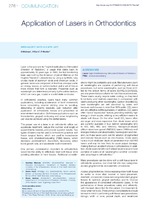| dc.contributor.author | Mulder, Riaan | |
| dc.contributor.author | Melman, Geoffrey | |
| dc.contributor.author | Karic, Vesna | |
| dc.date.accessioned | 2017-09-04T13:21:22Z | |
| dc.date.available | 2017-09-04T13:21:22Z | |
| dc.date.issued | 2017 | |
| dc.identifier.citation | Mulder, R. (2017). Application of lasers in orthodiontics. South African Dental Journal, 72(6): 276 - 277 | en_US |
| dc.identifier.issn | 1029-4864 | |
| dc.identifier.uri | http://ref.scielo.org/6pfvr9 | |
| dc.identifier.uri | http://hdl.handle.net/10566/3170 | |
| dc.description.abstract | Laser is the acronym for Light Amplification by Stimulated
Emission of Radiation, a usage that dates back to
approximately 50 years ago. In 1960, the first functioning
laser was built by the American physicist Maiman at the
Hughes Research Laboratories by using a synthetic ruby
crystal made of aluminum oxide and chromium oxide. In
general, lasers are composed of the three principal parts:
an energy source, an active medium and a set of two or
more mirrors that form a resonator. Properties such as
wavelength are determined primarily by the active medium,
which can be a gas, crystal or a solid-state conductor. | en_US |
| dc.language.iso | en | en_US |
| dc.publisher | South African Dental Association | en_US |
| dc.rights | This file may be freely used for educational uses. No commercial reproduction or distribution of this file is permitted without written permission of the South African Dental Association (SADA). Note that the SADA retains all intellectual property rights in the article. | |
| dc.subject | Light amplification by stimulated emission of radiation | |
| dc.subject | Laser | |
| dc.subject | Photobiomodulating (PBM) | |
| dc.subject | Orthodontic practice | |
| dc.title | Application of lasers in orthodontics | en_US |
| dc.type | Article | en_US |

